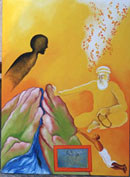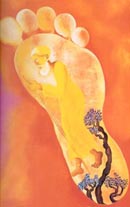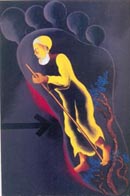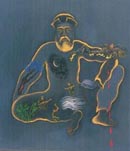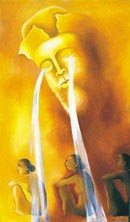About Me

Arpana Caur, a
Contemporary Indian Artist was in
born 1954. She is a distinguished Indian painter and has been exhibited
since 1974 across the globe. Her solos apart from Delhi, Mumbai,
Calcutta, Bangalore and Chennai have been held in galleries in London,
Glasgow, Berlin, Amsterdam, Singapore, Munich, New York and in Stockholm
and Copenhagen National Museum.
Her work can be seen in Museums of Modern Art in Delhi, Mumbai,
Chandigarh, Dusseldorf, Singapore, Bradford, Stockholm, Hiroshima, MOCA
LA, Peabody Boston, Asian Art Museum San Fransisco and Victoria and
Albert Museum London.
She has been extensively written about filmed, invited to various
countries and awarded, including a gold medal in VIth International
Triennele 1986 in Delhi. She was commissioned by Hiroshima Museum of
Modern Art to execute a large work for its permanent collection for the
50th anniversary of the Holocaust in 1995, and by Bangalore city and the
city of Hamburg to do large non-commercial murals in public spaces.
Since 1981 she did three large non-commercial murals in Delhi.
Today her paintings support several projects for the underprivileged,
including free vocational training in the Academy of Fine Arts and
Literature of which she along with her mother the renowned writer Ajeet
Cour, is the Founder Member. She supports a leprosy home in Ghaziabad,
and ration projects for poor and old widows.
-===========================================
Arpana Caur paints
from her heart, and nowhere is this more evident than in her paintings
that celebrate the life of Guru Nanak. Arpana is a devout member of the
Sikh community, for whom the religious and ritual activities of the
gurudwara are central to her life. Her faith has sustained her through
national and personal tragedies––and it has given her spiritual
fulfillment that is expressed so directly and sincerely in her art. Sikh
topics are by no means the sole form of artistic output for Arpana, who
has painted since she was a young girl. As she herself has stated, “I
have always been interested in very hard social issues…and the problems
between the haves and the have nots…if you are a painter how do you
resolve the socio-economic gap?” i These are rhetorical statements and
questions; however, they pervade Arpana’s life and infuse her art with
refreshing sincerity rarely witnessed in the post-modern world that is
driven by critical theory. It is, in fact, this spiritual yearning and
commitment to preserving Sikh culture that brought Arpana’s work to the
attention of Dr. Narinder S. Kapany––they are kindred spirits in their
humanity and generosity.
Click images to view gallery
Arpana was born in Delhi in 1954, seven years after Partition.
Her family like millions of others had been uprooted from their home in
what is now Pakistan, and made their way down to Delhi in India. She
grew up in a world that was torn apart by communal dissension. Her
grandfather, a physician, tended to the poor and the homeless, and as a
young girl Arpana went with her mother to distribute rice, food and
blankets to the destitute. Thus she grew up in an atmosphere of
selflessness that would provide the background for her creative energy.
The stories of Guru Nanak, of Sufi saints, of the Buddha, and of
Sohni-Mahiwal occur throughout her oeuvre, as does the theme of
contending opposition in her series of paintings entitled Between
Dualities, in which the continuum that divides life and death, light and
darkness, enlightenment and oblivion is the cosmic joke, and time is
the metaphor for the universal soul.
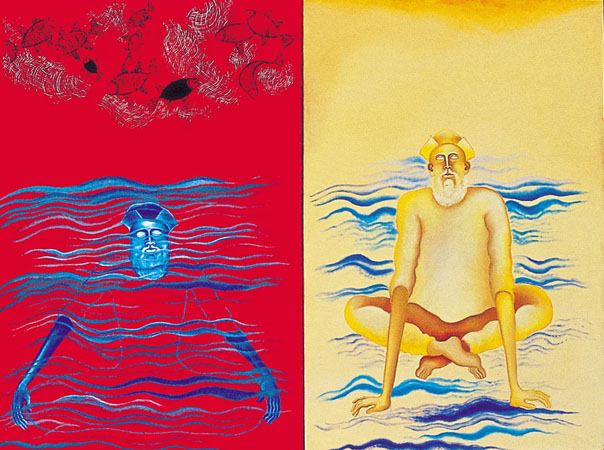
In Arpana’s painting Immersion/Emergence, the duality expressed is
that of before and after, of searching and finding, and of ignorance and
knowledge. In this diptych she evokes the idea of duality in the
miraculous experience that Nanak underwent when he retreated from the
world and was submerged under water for three days in 1499 at the age of
30. When he reemerged he uttered some of the most profound verses on
the oneness of all beings. As with many myths and legends, heroes must
undergo ritual separation, isolation and initiation in order to become
inspired, mature leaders. Nanak’s immersion provides the catalyst for
his revelation and insight that he expressed as Ikk Oan Kar (the One
Divine Being)––there are neither Hindus nor Muslims, only Humans. This
profound enlightenment provides the humanistic keystone for Sikh
culture. In the painting on the left Nanak is submerged in the watery
depths; he is described in blue, the same blue of the waves that wash
over him. Blue symbolizes the infinite and contrasts with the intense
red background, the color of passion, power and blood; these are the
colors that become the transformative force that enters into Nanak’s
being after which he is enveloped in the golden glow of joy and
enlightenment, as he rises above the waters.
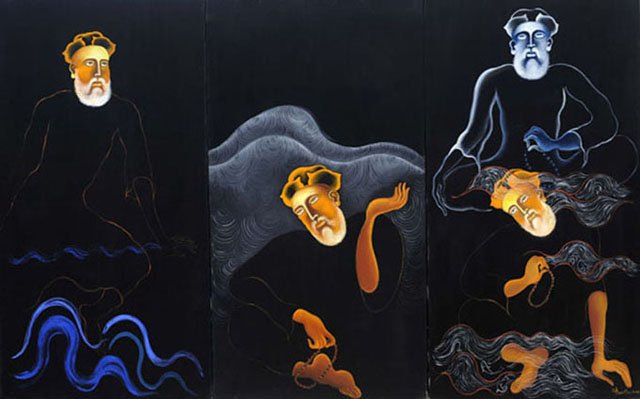
Arpana works in series, often repeating themes in diverse ways. In
her triptych entitled, Immersion, Emergence, 2003, she describes Nanak’s
spiritual quest in a powerful set of paintings set against a dense
black background.ii In this triptych the element of narration encourages
the viewer to follow Nanak into the waters and sit with him in his
submerged state as he fingers his rosary, before emerging at the top of
the right painting. The darkness of the paintings castes a spell giving a
timeless quality to the period of Nanak’s immersion when the world
itself seemed to die.
The Golden Saint is a parable of good versus evil, of positive versus
negative, and of playing with the complementary opposing forms of
dualities, that records an episode that occurred in the Punja Sahib,
wherein Nanak prevents a mountain from crushing him by merely holding up
his hand. This is also a theme that Arpana has painted several times,
and one that is derived from 19th century miniature paintings. Here
Nanak robed in brilliant gold is showered with cascading flower petals
as he holds out his right arm and pushes against a mountain top that is
cleft by a blue running stream, over which hovers the ghost-like shadow
of a man. Arpana’s paintings are inspired by the nineteenth-century
miniature tradition of the Pahari styles of the Punjab Hills. They
include the bold Basohli school, and the romantic Kangra and Guler
schools that produced some of the most lyrical paintings in Indian art.
Here the finger-like extensions of the rocky mountains are seemingly
joined in the pious namaste mudra (greeting gesture), that recall the
highly stylized slopes and colorings found in early Pahari paintings. It
is as if they have recognized the great spirit of Nanak and are
imploring him for forgiveness. The small figure of a woman in the inset
red-bordered painting holds her hands out towards Nanak, echoing the
sentiments of the mountains.
Wherever water flows it carves its way through terrain, dividing and
separating. Arpana uses water in many of her paintings in a similar way
as a formal device to divide her compositions. In the highly original
painting of Dancing Nanak, the sinuous lines of the blue river of life
are echoed in the curves of Nanak’s dancing body. Flames erupt from the
curves of the river like festering sores, reminding us of the eternal
duality that exists between fire and water. They also remind us of the
continuing tensions in the Punjab, the region of the five rivers that
throughout its history has been an area that has witnessed waves of
invading forces making their way down into the rich plains of India.
This same area witnessed the greatest transmigration of people in the
world’s history in 1947. It was a tragic event that continues to be
played out today in the political tension between India and Pakistan,
and Arpana inserts both the ambiguity and the duality of the continuing
political tensions into this painting of Nanak. The joyous dance of
Nanak, who danced in the way of the mystic Sufis to express his
spiritual devotion, is tempered by the flaming river––a reminder of
the insolvency that can overwhelm the human spirit. In the Shivaite
context the dance becomes the catalyst that destroys ignorance and the
demonic powers of darkness in order to restore life. Fire burns,
destroys and cleanses in order to bring forth life. Water also possesses
these dual powers of destruction and creation. In Arpana’s painting the
rhythm of the dance gives visible energy to Nanak’s joy and his sense
of hope.
Endless Journeys is a series of paintings that depicts Nanak’s
wanderings throughout the Punjab and his pilgrimages to Hindu and Muslim
sacred places, spreading the message of One God (ikk oan kar), the
equality of all men, the rejection of the caste system, and the futility
of physical existence. He is accompanied by his two faithful followers,
Bala, who was Hindu, and Mardana, a Muslim who played the rabab (lute)
as music for Nanak’s devotional songs. In one painting three large
footprintsiii enclose the three wanderers: Nanak robed in gold walks
with his staff, Bala follows with a water bottle, and Mardana walks
behind clasping his rabab.
In the painting owned by Dr. Kapany, Arpana has drawn one large
golden footprint that appears to float in the firmament. Enclosed within
it is the radiant figure of Nanak walking with his staff. His
companions are no longer with him; he walks alone, intent on his quest
to spread his teachings.
In an almost identical painting entitled, In Bleeding Times, 2002, the
golden-robed figure of Nanak continues to stride forward, but now the
footprint is black. It is backlit by an ominous red glow as it floats
against a dark grey-black background. An even blacker arrow impedes
Nanak’s progress.iv It seems that communal tensions and violence will
never cease.
The reality of reoccurring warfare is expressed in Arpana’s iconic
seated figure of Nanak.v In this magnificent painting, as also in the In
Bleeding Times series, Nanak is seated in the posture of royal ease
with one leg bent vertically at the knee. His body floats upon a black
background and is contoured by a golden glow, inside of which soldiers
are fighting each other and hunting animals; blood is pouring from the
lifeless carcass of a tiger. Within Nanak’s right arm is the tree of
life with its blue leaves, the same tree that appears in the footprint
paintings of Nanak’s peregrinations. The stylistic tradition of painting
figures within figures, and figures formed of figures, is one that was
popular during the period of the Deccani Sultanate in the 17th and 18th
centuries. Then it was more of a visual conceit and a decorative
conundrum. Arpana has exploited this normally playful approach to imbue
her rendering of Nanak in the fullness of his compassion.
At the heart of Guru Nanak’s life and teachings was his consummate
sense of humanity and compassion. In her painting entitled, Compassion,
2002, the large, golden head of Nanak appears from the firmament like
the rising sun. Pouring from each of his eyes like waterfalls are two
streams of water that bathe three seated female figures below. In his
great compassion, Nanak is shown bathing away the sins of the world in
order to restore life and hope. The small figures are Arpana, who is
herself wholly embraced by the love and teachings of Nanak. This
painting, perhaps, more than any of the others speaks to Arpana’s own
sense of being Sikh. In a series of paintings that has celebrated the
miraculous and legendary life of Nanak, Compassion, brings the Sikh
experience into the present and into the personal and private sphere of
experience.
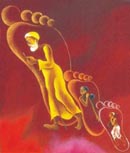
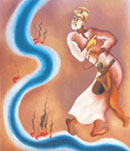
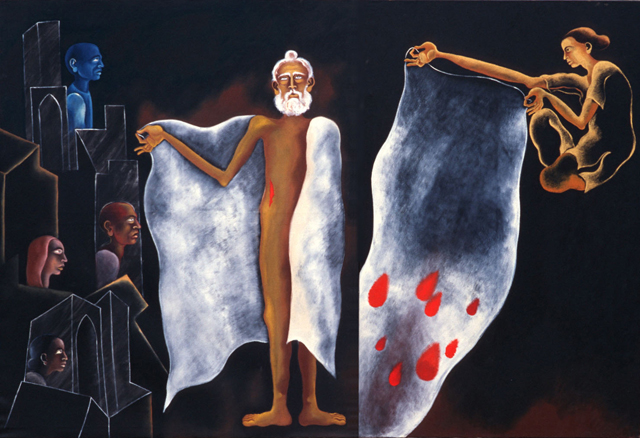
Arpana lived through the riots of 1984 and witnessed the horrors of
communal hatred that was perpetrated upon the Sikh community. Her
passion and compassion rise out of her own experiences and as a result
her art rings with great empathy for the condition of mankind. In Wounds
of 1984, Guru Nanak stands half naked, half robed in a white cloth,
again against a black background that castes the pall of endless night
over the painting. He is watched by figures to the left who peer out of
compartment-like buildings. But the question remains: Who is the
standing figure? Is it Guru Nanak? Is it Arpana’s grandfather who fled
with his family from Pakistan to India in 1947, as millions of others
did? Or, is it Everyman? In the right panel, a seated woman, Arpana,
holds up a blood-stained cloth that flows across the canvas like a
silver river.
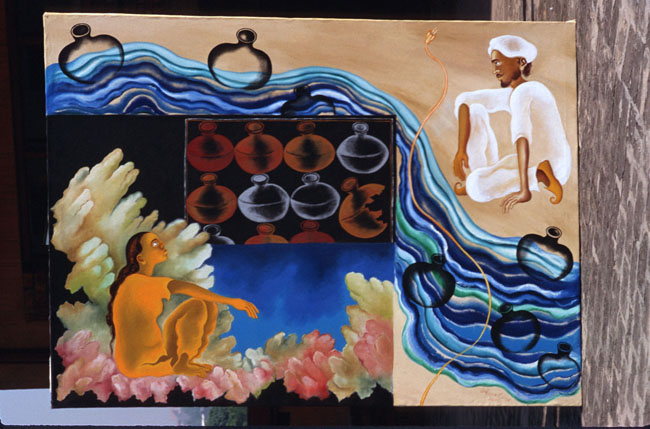
Arpana’s use of color in her paintings sets up moods that encompass
the whole range of human feelings from ecstatic bliss to despair that in
turn draw upon rasa, aesthetic emotional sentiments that are
experienced upon seeing a moving work of art, hearing sublime music, or
being stirred by the exquisite movements of dance.vi In her painting of
Sohni Mahiwal that is in Dr. Kapany’s collection it is the vibrant
palette that immediately draws the rasika, the viewer, into the world of
Sringara Rasa, the first and most important of all the rasas. It is the
rasa that expresses the depth of feeling between two lovers. It is the
passion of the human heart for the divine. It also expresses
transgressive love for the forbidden or the unattainable. Sringara Rasa
is manifested in two ways, that of sambhoga, love in union, and that of
vipralambha, love in separation; it is the latter that is so clearly
portrayed in this painting of the two young lovers, Sohni and
Mahiwal––the longing that occurs when lovers are apart. This is
described by Sufis as ishq majazi, human love, for ishq haqiqi, love for
God. It is the unrequited universal love of the ages of Laila and
Majnu, of Heer and Ranjha, of Sassi and Punnu, and of Romeo and Juliet.
Sohni and Mahiwal were from two different worlds, she was the
daughter of a potter, he was a rich trader from Bukhara. They fell
passionately in love with each other. Mahiwal gave up his lucrative life
and became a buffalo herder just to be close to Sohni. Inevitably their
love for each other was discovered and her parents hastily married her
off. At this turn of events Mahiwal renounced the world and became a
faqir, hermit, living in a small mud hut across the Chenab River. At
night, under the cover of darkness, Sohni would come down to the river
to meet Mahiwal who had swum across it to be with her. Mahiwal injured
himself in his selfless drive of love for Sohni, so she started to swim
across the river with the aid of a clay jar; predictably, her absences
at night were discovered, and one night her sister-in-law followed her
to the river. The following night the sister-in-law replaced the clay
jar with an unbaked jar that began to dissolve as soon as Sohni entered
the water with it, and in mid-stream she drowned. Mahiwal was so
distressed at seeing Sohni’s death that he plunged into the river and
drowned as well, and so ultimately this ill-fated affair came to naught.
In Arpana’s painting the lovers’ worlds are separated by the
fast-flowing blue and green waters of the Chenab that divide it
diagonally. Transparent jars outlined in black float upon its surface as
reminders of past trysts. Mahiwal, dressed in white, sits on the
sandy-colored shore patiently waiting in the upper right hand corner.
Yet it is Sohni that captures the imagination. She sits in the lower
left corner of the painting, gazing over the river to Mahiwal. The rigid
rectangle in which she sits acts as a constraint and a warning. The
rows of jars against the black background add further ominous tones,
emphasized by the broken jar that offers a premonition of what is to
happen. Yet it is the crystal-like fingers that enclose Sohni that
electrify her emotional state. In icing pinks, jade greens and creamy
yellows the fingers of the crystals enfold her, opening up to reveal her
radiance like an embedded jewel. These forms can also be read as clouds
that will transport her to her beloved, if only in her imagination.
The Punjabi legend of Sohni and Mahiwal is the source of folksongs,
plays and films based upon the life and love of a real potter who lived
some five hundred years ago in Akhnoor by the Chenab River that runs
through Jammu and Kashmir. The intensity of the love that is expressed
in this romantic tale is that of vipralambha, love in separation. In
fact the formal aspects of the composition serve to emphasize the
tensions of the inaccessible. Even the unplugged electrical cord that
winds up along the surface of the painting, like a snake rising from its
master’s basket, seems to be seeking a socket that would allow the
magic to happen, yet further serves to separate Sohni and Mahiwal. This
is an incredibly powerful painting of the depth of human love for the
divine, and the risks that are taken to seek fulfillment.
It is hard to extricate the painter from the paintings in the art of
Arpana Caur.vii She lives her life as one called to profess her faith in
Sikhism through her art and through her enormous generosity and
selflessness. Her inspiration and her paintings are a guide for all of
us.



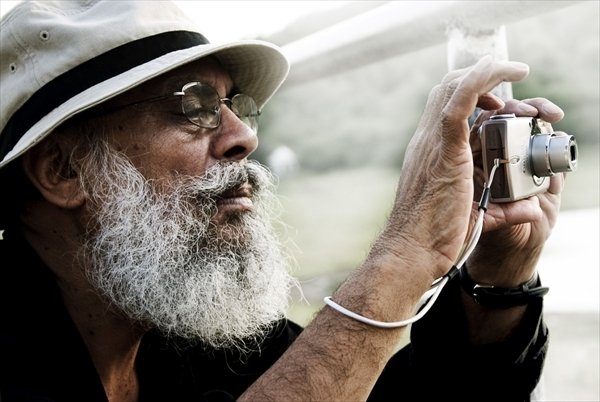

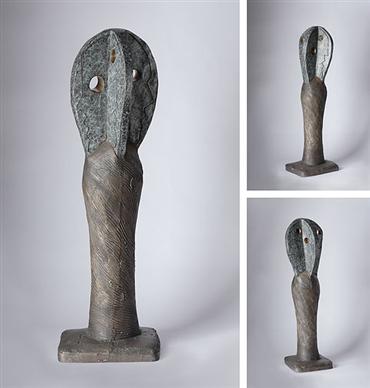







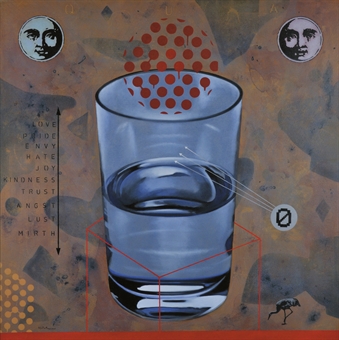

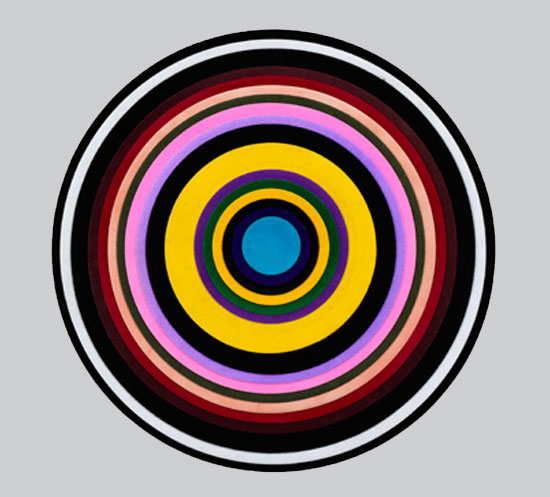
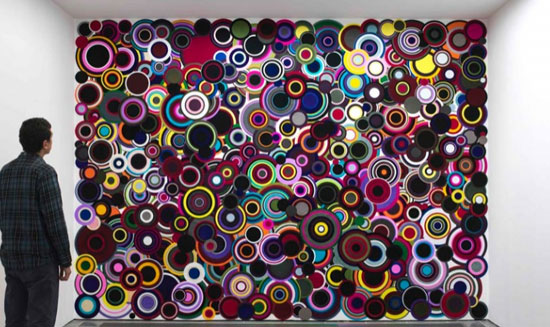
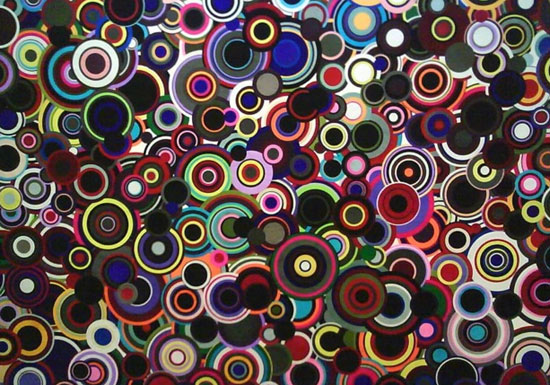
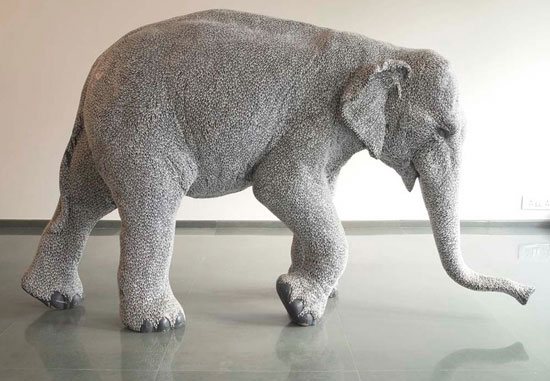
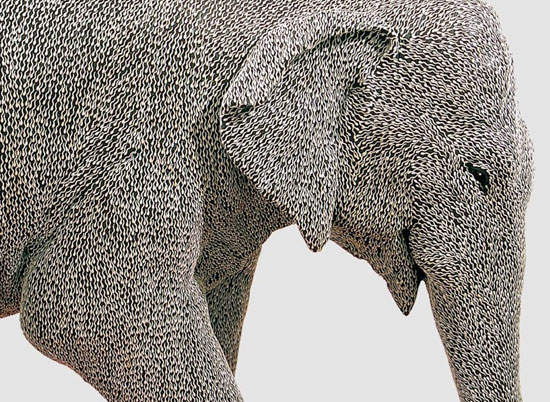
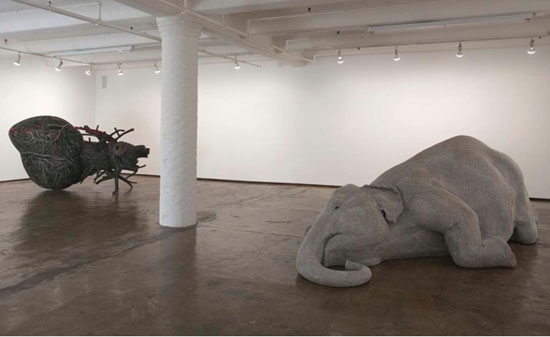
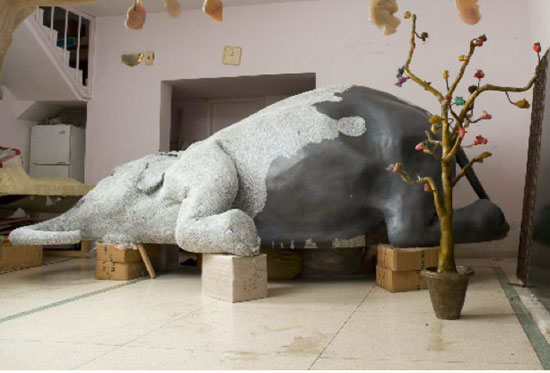
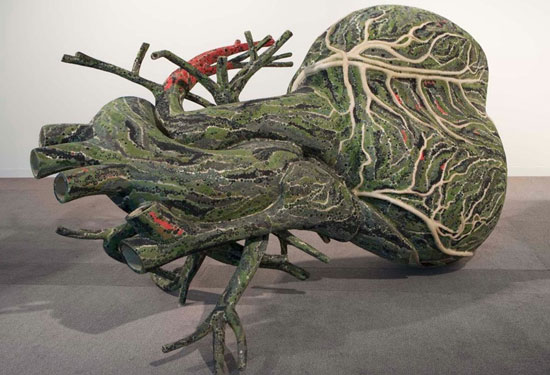
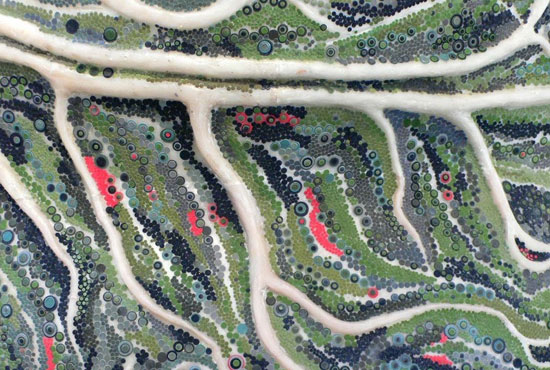
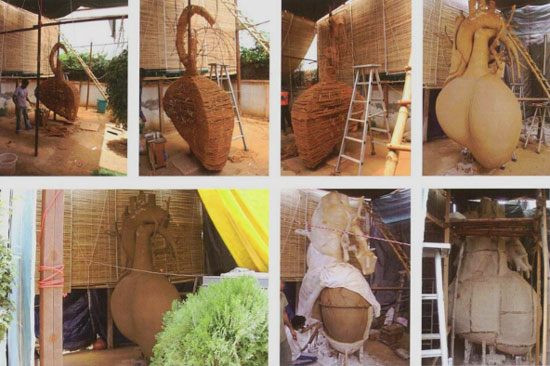
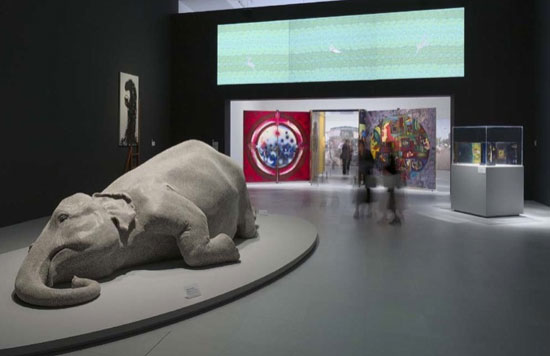




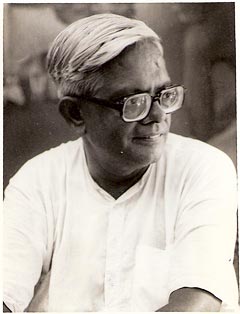
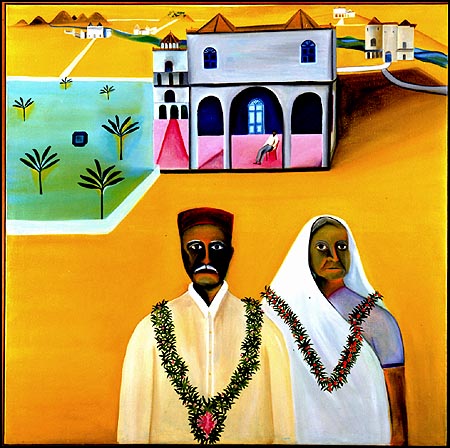



 Arpana Caur, a Contemporary Indian Artist was in
born 1954. She is a distinguished Indian painter and has been exhibited
since 1974 across the globe. Her solos apart from Delhi, Mumbai,
Calcutta, Bangalore and Chennai have been held in galleries in London,
Glasgow, Berlin, Amsterdam, Singapore, Munich, New York and in Stockholm
and Copenhagen National Museum.
Arpana Caur, a Contemporary Indian Artist was in
born 1954. She is a distinguished Indian painter and has been exhibited
since 1974 across the globe. Her solos apart from Delhi, Mumbai,
Calcutta, Bangalore and Chennai have been held in galleries in London,
Glasgow, Berlin, Amsterdam, Singapore, Munich, New York and in Stockholm
and Copenhagen National Museum.








